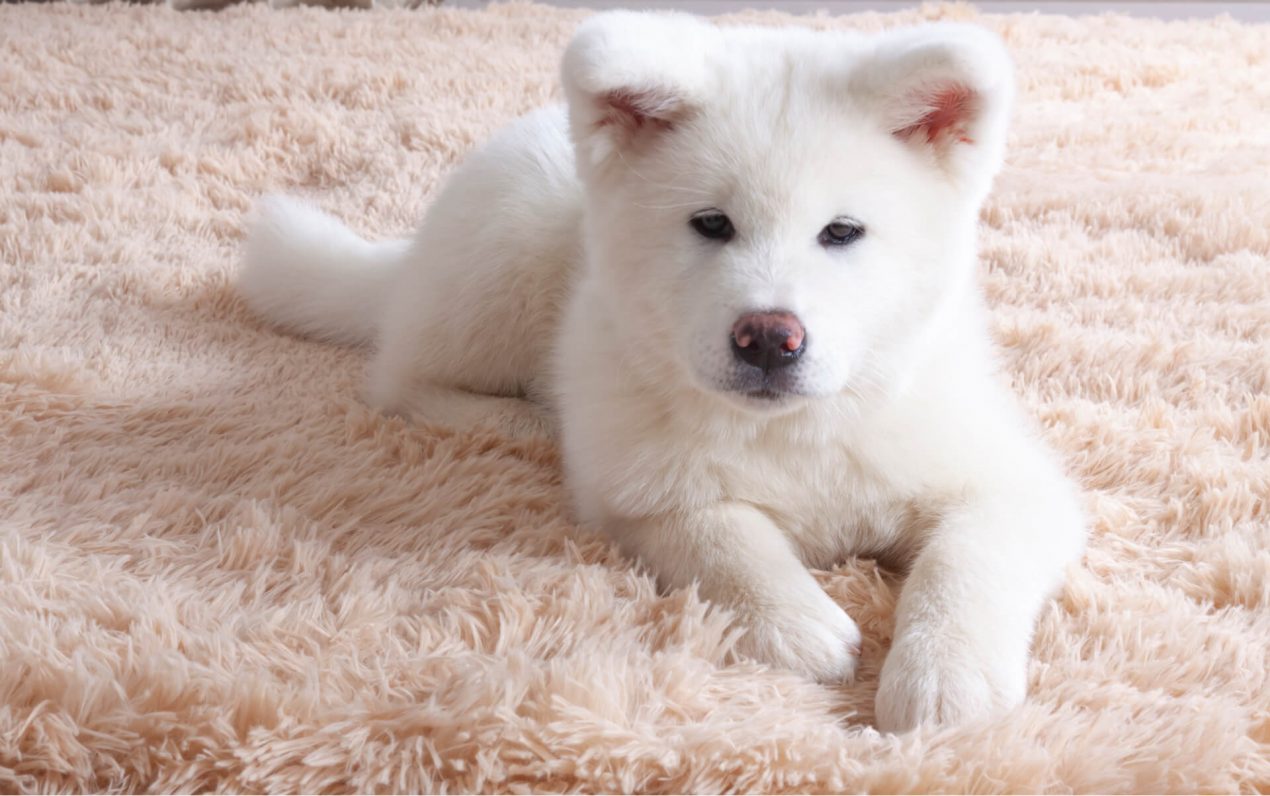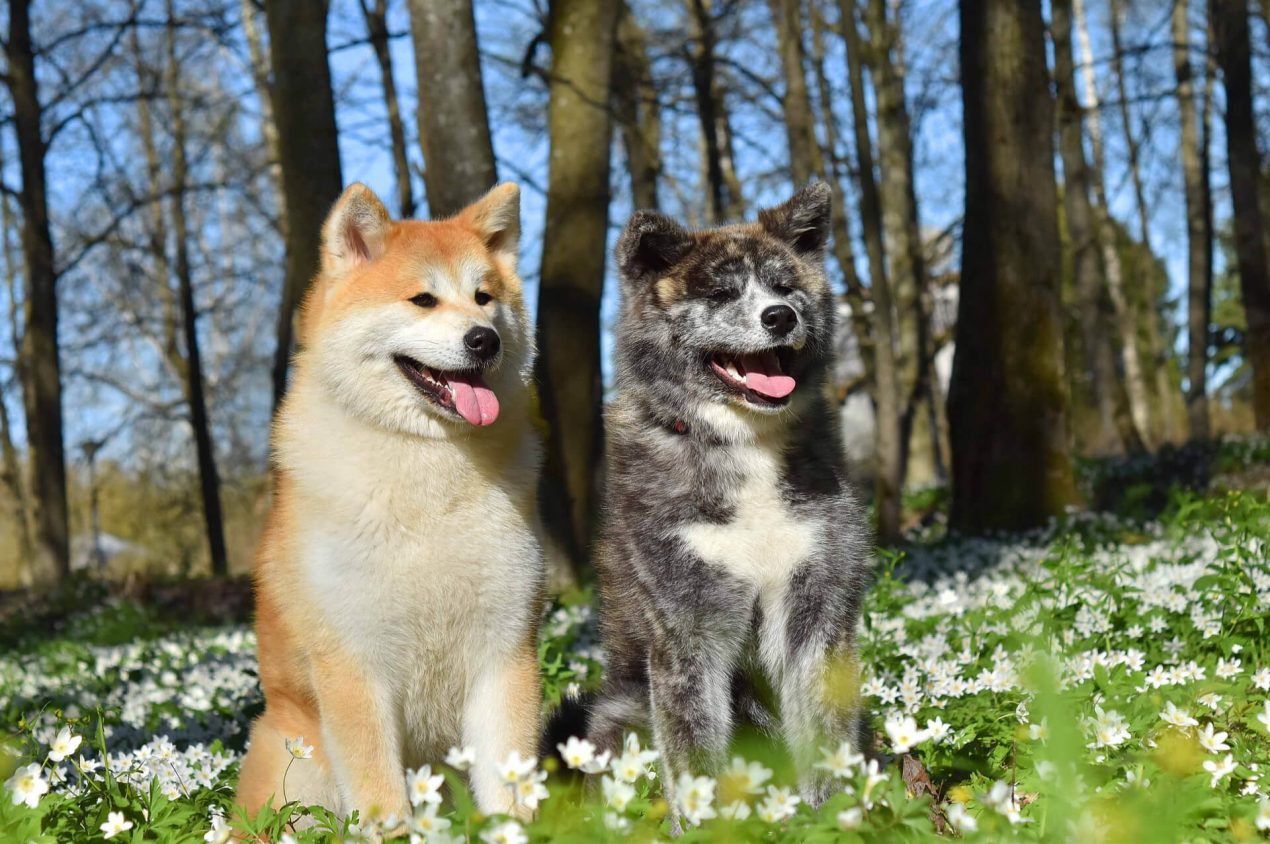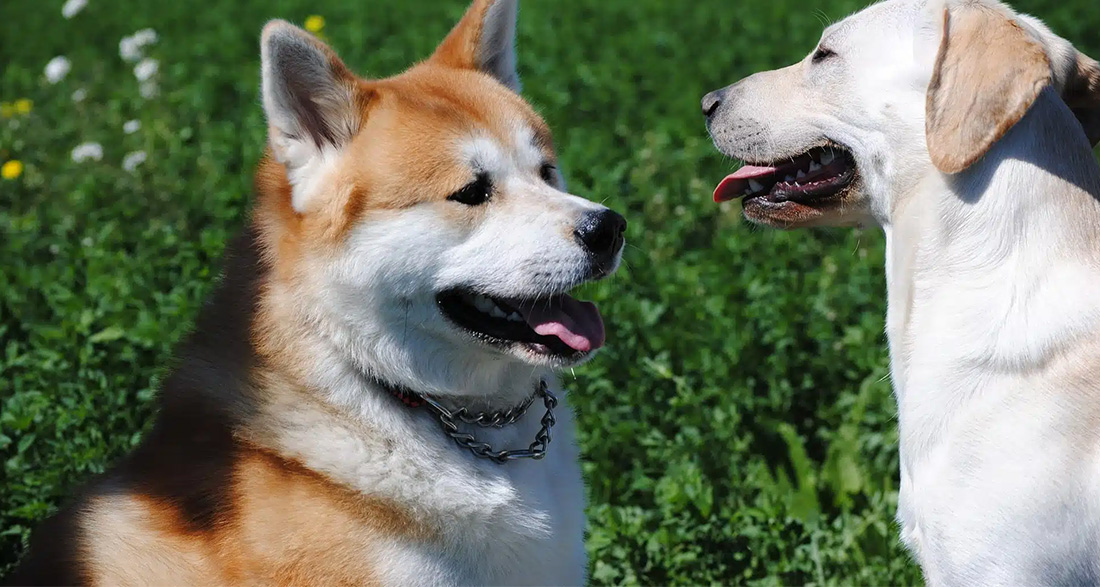The breed Akita (Akita Inu, Akita Ken) from Japan has become familiar to many people, especially after the movie “Hachiko – A Dog’s Story.” This original hunting dog is a symbol of loyalty and devotion in its homeland. In this profile, you’ll learn everything about the history, temperament, and care of these proud dogs.
History of the Akitas
The Akita Inu, one of the oldest and culturally significant breeds, originates from the Akita Prefecture on the Japanese island of Honshu. Evidence of dogs resembling today’s Akitas dates back around 5,000 years in Japan, found in depictions on pottery and bronze bells from the second century BC.
During the Tokugawa period until the Taisho era (1603 – 1925), Akitas accompanied samurais as loyal companions, forging a deep bond between the breed and Japanese culture. In 1931, Emperor Hirohito declared the Akita a natural monument and national treasure, severely limiting its export from Japan.
Evolution and Challenges of the Akita Inu
From around 1915 to 1947, the appearance of Akitas underwent drastic changes, mainly due to crossbreeding with other breeds such as the Mastiff. These changes led to the development of two main bloodlines: the Ichinoseki and Dewa lines. The latter was considered undesirable in Japan by the mid-1950s.
The Akita Inu has its roots in the Jomon period and was originally bred for hunting large game like bears and wild boars. Over time, the Akita became a symbol of health, happiness, and longevity in Japan. The story of Hachiko, the faithful Akita who waited for his deceased owner, illustrates the deep bond and loyalty of this breed.
In the 20th century, the Akita Inu faced significant challenges. During World War II, many Akitas were in danger as the government ordered the killing of all dogs except German Shepherds. Some Akitas were kept hidden or crossed with German Shepherds to save them. After the war, breeders worked intensely to restore the breed to its original state.
Despite these challenges, the Akita Inu has maintained its position as one of the most significant and revered dog breeds in Japan. Their unwavering character and deep connection with Japanese culture make them a true treasure of the animal world.
Near Extinction of the Breed
During World War II, many Akitas were used as sources of meat and fur, nearly leading to the extinction of the breed. After the war, almost all Akitas had ancestors from crossbreeding. The Japanese worked to revive the original form of the “Matagi Akita” by crossing the remaining dogs with Japanese sled dogs and the Chow Chow. This resulted in the smaller, often reddish or sesame-colored Akita.
The larger Akitas, descendants of fighting dogs resulting from crossbreeding, were no longer desired in Japan. The slimmer and larger dogs, crossed with German Shepherds, made their way to the USA and evolved into the separate breed of the American Akita. Since 1999, the Akita Inu and the American Akita have been officially recognized as separate breeds by the FCI, belonging to Group 5 “Spitz and Primitive Types” in Section 5 “Asian Spitz and Related Breeds.”
Breed Overview
GROUP: Working
HEIGHT: 26 to 28 inches (males); 24 to 26 inches (females)
WEIGHT: 100 to 130 pounds (males); 70 to 100 pounds (females)
COAT: Short, thick, double-layered coat and some Akitas have a recessive gene that gives them a long coat
COAT COLOR: Brindle and pinto (each with white markings)
LIFE SPAN: 10 to 13 years
TEMPERAMENT: Affectionate, loyal, independent, protective
HYPOALLERGENIC: No
ORIGIN: Japan
Nature and Character
The Akita Inu is a dog breed known for its loyalty, pride, and independence. These traits make the Akita Inu a special companion and a challenge at the same time.
They are distinguished by their unique temperament. These dogs are intelligent, confident, and independent. Their independence is particularly noteworthy, setting them apart from other breeds. They demonstrate courage and dignity in their behavior. The Akita Inu is inherently sovereign, thoughtful, and remains calm even in hectic situations. It exudes calmness and dignity, yet one can still recognize in many Akitas the ancient hunting dog, with traces of primal instincts still present.
A significant aspect of the Akita Inu’s character is its pronounced protective instinct. They are excellent guard dogs and passionately protect their family. They do not act aggressively without reason but are always alert and watchful. Their loyalty and reliability as protectors are deeply embedded in their DNA.
Toward their owner, the Akita Inu is devoted in loyalty, fond of children, and very friendly towards them. However, they may not always get along well with other dogs and can be quite dominant and sometimes even confrontational towards them.
Despite their independence, Akitas require consistent training. A strong bond, as well as clear rules and boundaries, are essential. Patience and understanding are needed when dealing with this breed. While they are independent, they also seek a strong leadership figure.
The Akita Inu is a confident and calm dog, preferring to act independently and not submissive. It remains neutral to indifferent towards strangers and only shows aggression when it perceives its family in danger. Akitas are not inherently dangerous, but lack of exercise can lead to aggression. They get along with children but should not be left unsupervised with them. These dogs often form strong attachments to a single person. Those who earn their loyalty gain a cooperative and reliable partner. In stressful situations, they remain calm, but their original wildness may emerge when they spot prey. Additionally, many males are incompatible with unfamiliar dogs.
| Affection Level | High |
| Friendliness | Low |
| Kid-Friendly | Low |
| Pet-Friendly | Low |
| Exercise Needs | High |
| Playfulness | High |
| Energy Level | High |
| Trainability | Medium |
| Intelligence | Medium |
| Tendency to Bark | Low |
| Amount of Shedding | High |
Appearance of Akitas
The Akita Inu is an impressive, large, and muscular dog with a majestic appearance. There is considerable variation in size within this breed, depending on gender and the two main lines, the Japanese Akita Inu and the American Akita. Females typically stand about 58-64 cm tall, while males stand about 64-71 cm tall. The weight of females ranges from 23-29 kg, while males weigh between 32-40 kg.
A characteristic feature of the Akita Inu is its coat. It consists of coarse, short guard hairs with a soft undercoat. You’ll notice that the coat is often two-toned, with the base color often being white on the belly, face, and inner sides of the legs, while the back and outer sides of the legs are often reddish-brown brindle. Additionally, the coat is distinguished by the “urachiro” feature – whitish hair on the sides of the muzzle and cheeks, on the underside of the jaw, neck, chest, body, and tail, as well as on the inside of the limbs.
The eyes of the Akita Inu are brown with pronounced black eyelids, adding depth to its appearance. Its characteristic triangular ears and broad forehead with a furrow give it a cute yet impressive look. Coat care is relatively simple, especially outside of shedding season. The coat effectively protects it from cold weather conditions.

Puppy Training
Training an Akita is a challenging yet rewarding task that requires careful consideration, consistency, and patience. This dog is less suitable as a first-time pet, as even experienced dog owners may find training it challenging.
The Akita is intelligent and trainable but always retains a certain level of independence. With the right approach and diligent training, you can turn it into a reliable, friendly, and pleasant companion. Sensible yet consistent training is essential. Aggressive or loud behavior from the owner can unsettle the dog and make cooperation difficult. Instead, a positive and trusting relationship is crucial.
If you encounter difficulties in training, don’t hesitate to seek professional assistance from a dog trainer. Work together on basic commands, social behavior, hunting instinct, and protective instincts. An important aspect of training is the Akita’s dominance behavior. Consistency is key to success in maintaining the hierarchy.
The Akita Inu often displays dominance towards other dogs. Good socialization can help make it somewhat more relaxed, although it is naturally more of a solitary creature. Sometimes, it’s better to keep a certain distance from other dogs.
When training the puppy, be firm and consistent yet friendly. Only then will the Japanese dog become a faithful and loyal companion. The breed does not tolerate violence well and may react with stubbornness or aggression. Early and comprehensive socialization with other dogs and people is essential for harmonious living together.
Activities with the Akita
The independent-minded Akita needs its daily exercise but will only participate if it feels like it. If it doesn’t feel like moving, it’s hard to convince the dog otherwise. It also enjoys lying in its basket and sleeping. The dog’s athletic motivation mainly depends on whether it sees a purpose behind the exercise. The owner’s motivation to convince the dog that obedience benefits it is crucial. The serious breed dog is difficult to enthuse about silly games or athletic tricks.

Akita Care
The Akita Inu is an easy-to-care-for dog known for its cleanliness. These dogs hardly smell and are very clean. You’ll find that the Akita Inu’s hard guard hair is self-cleaning and does not need to be washed or specially maintained. However, during shedding season in spring and autumn, your assistance is needed as the dog sheds much of its thick undercoat. During this time, you should brush it daily.
Regular grooming is essential to ensure the health and well-being of the Akita Inu. Brushing becomes particularly important during shedding seasons, as the dog loses its undercoat and can create a hairy surprise. For about two to three weeks, the Akita Inu needs to be brushed daily to deal with the shed hair. This regular grooming not only ensures that your dog shines in new splendor but also makes it easier to keep your home clean. After this intensive grooming phase, you can once again enjoy a well-groomed and shiny Akita Inu.
Health and Hereditary Diseases
The Akita Inu is a robust and resilient breed of dog, but it can be prone to certain health issues. Understanding the specific health risks of this breed allows you to take proactive steps to keep your faithful companion healthy and happy.
Common health problems include skin and coat conditions such as sebaceous adenitis, a condition that leads to dry, scaly skin, broken hair, bald spots, and intense itching. Autoimmune diseases can affect various organs and systems of the dog, including the skin, blood cells, and endocrine system. Hip dysplasia (HD), a common condition in large breeds, can lead to painful joint problems. Hereditary eye diseases such as progressive retinal atrophy (PRA) can lead to blindness.
Early detection of these problems is crucial, with regular veterinary check-ups helping to identify signs such as changes in skin and coat, joint issues, or changes in behavior and activity early on. Treatment for hip dysplasia involves various approaches depending on the severity, from conservative methods such as physiotherapy and medication to surgical intervention. Skin problems require early and comprehensive treatment, including special shampoos, medications, and tailored nutrition.
Most Akita Inus remain healthy throughout their lives. However, issues such as allergies, skin diseases, and joint conditions like elbow dysplasia can arise as they age. The average life expectancy of an Akita Inu is around 12 years or more. You can support the health of this breed by providing adequate exercise, appropriate grooming and attention, and a balanced diet.
Is the Akita Right for Me?
Anyone looking to bring a beautiful Akita home needs experience with dogs and an understanding of the peculiarities of Asian breeds. These independent-minded dogs require strong and confident leadership to become obedient companions. Generally, the breed is only recommended for people who have the time and desire to seriously and intensively engage with their dog. They may be suitable as a second dog, but particularly males can be hostile towards other dogs. If you’re confident about the breed, it’s best to find a breeder affiliated with the Akita Club of America. Expect to pay between $1500 and $2500 for a purebred puppy with papers. You may also find representatives of the breed in animal shelters looking for new homes.

Interesting Facts
Perhaps the most famous representative of the breed was the Japanese male Hachikō, born in Odate in 1923. His owner, a music professor, took him to Tokyo, where the dog greeted him at the station every day after work. When the professor died of a cerebral hemorrhage during a lecture on May 21, 1925, his widow gave the dog to relatives. Hachikō ran away from there daily and arrived at the station every day at a fixed time to wait for his master.
For the next nine years, the loyal dog waited for his master every day. After his own death in 1934, the city erected a bronze statue in his honor on the west side of the station. In 2009, director Lasse Hallström adapted the story and produced the film “Hachiko – A Dog’s Story” based on the Japanese dog.
Akita Overview
Pros
- Protective
- Forms strong, loyal bond with owner
- Brave
Cons
- Sheds profusely
- Stubborn, difficult to train
- Can be aggressive toward other dogs
- High prey drive
- Doesn’t tolerate hot weather
Do you have an Akita or are you planning to get one? Share in the comments what makes it so special in your opinion!


